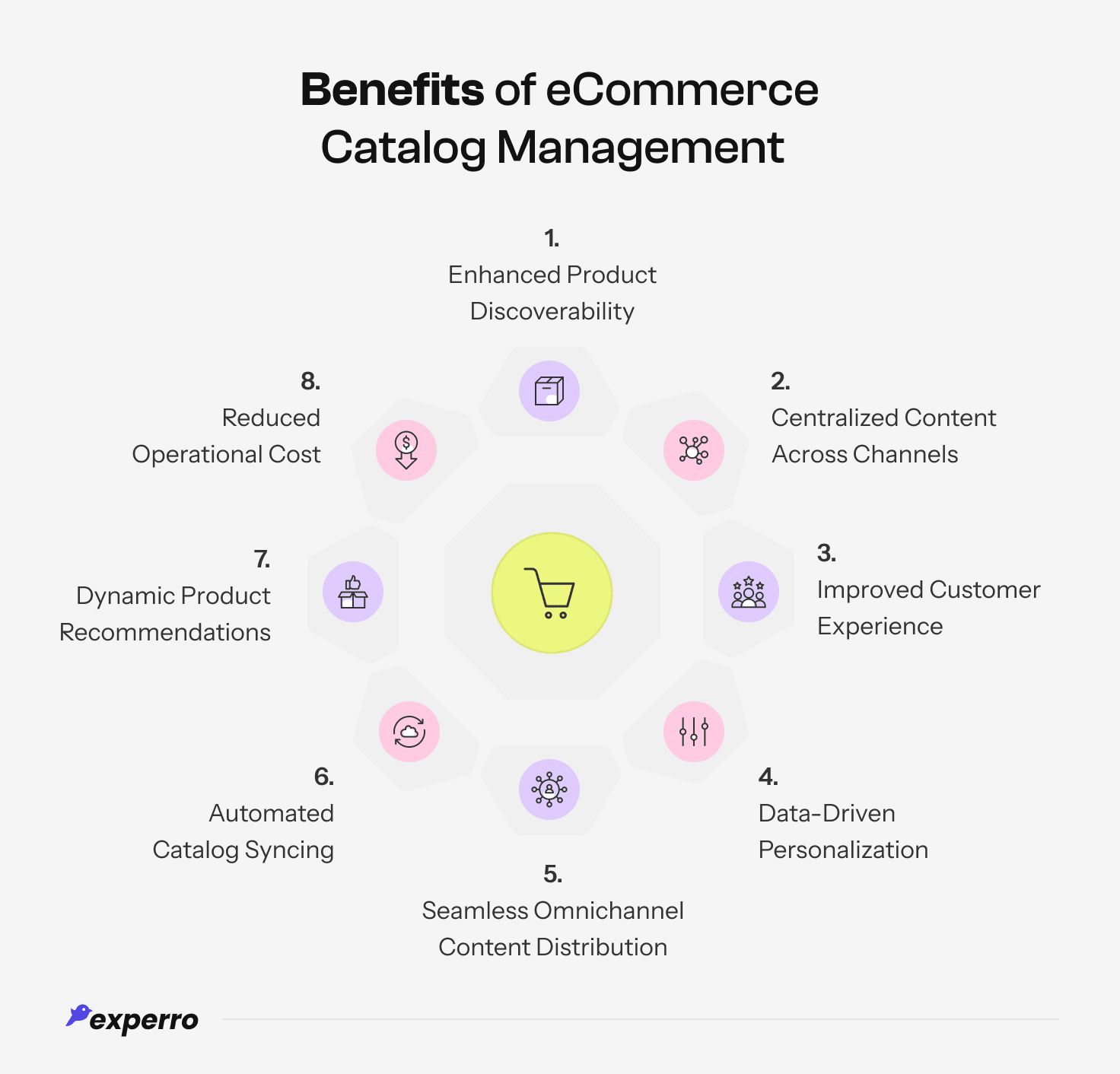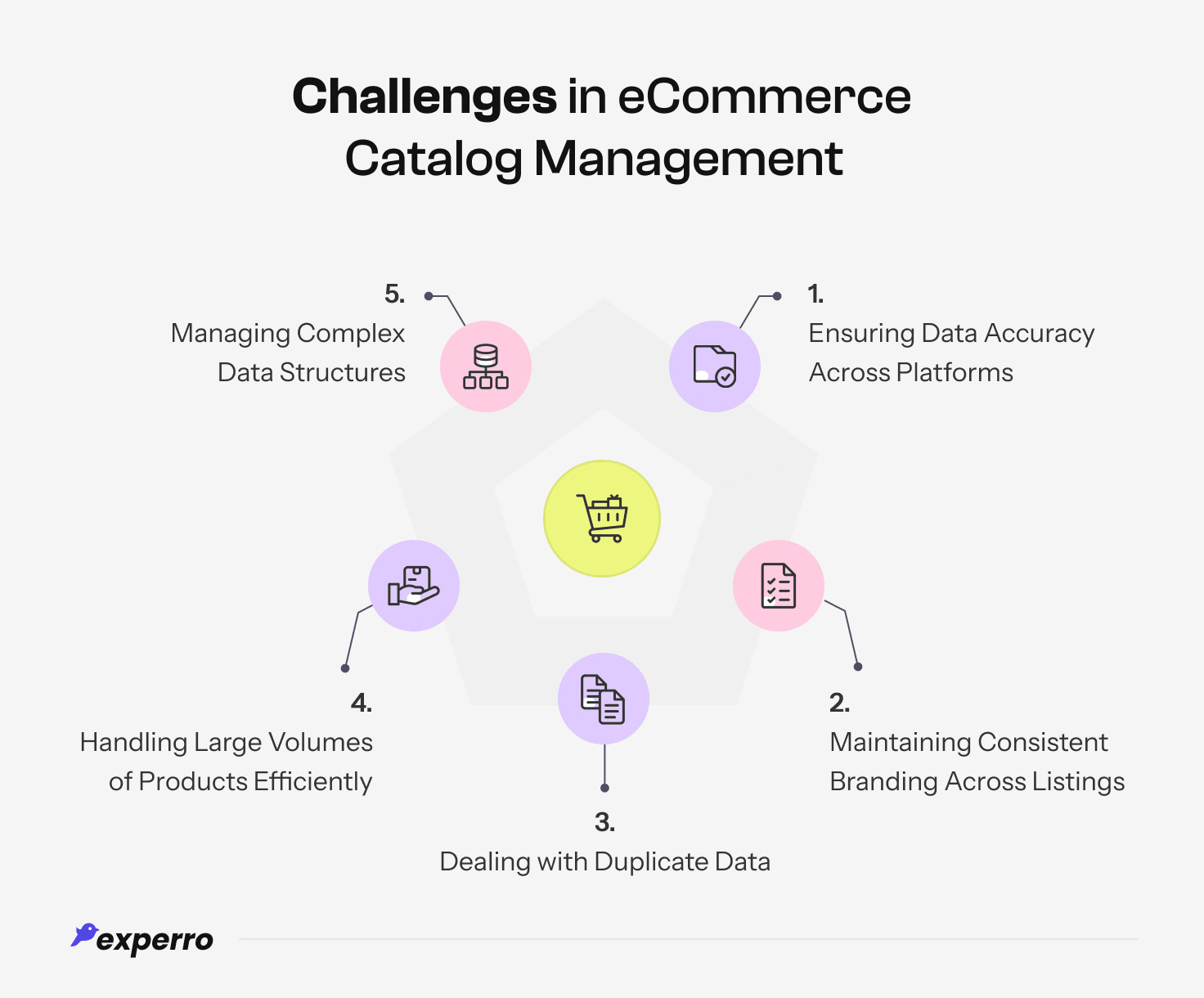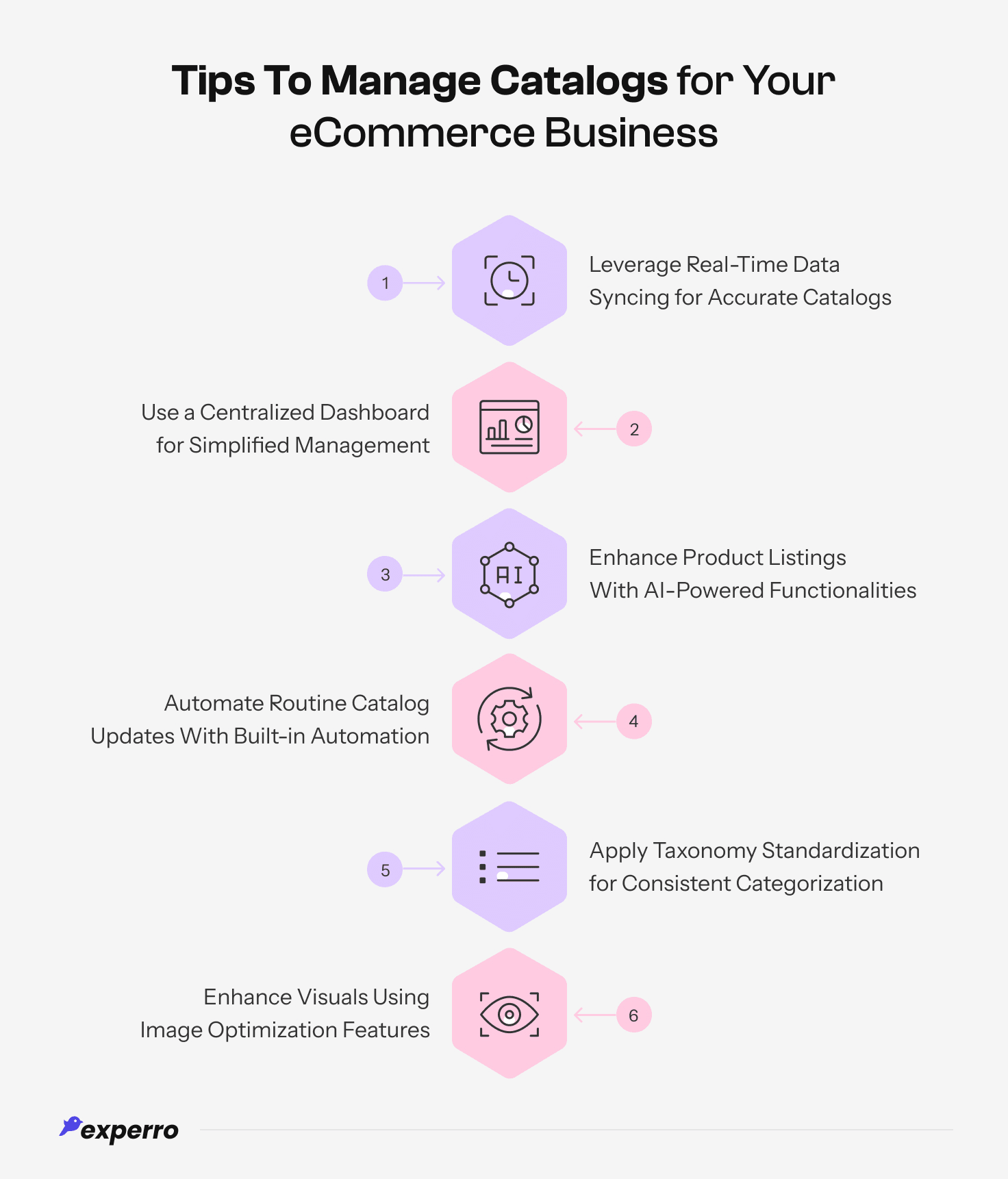- Blog
- Merchandising
- Personalization
- eCommerce
- 8 min read
Why & How To Automate eCommerce Catalog Management in 2026?
Published
8 November 2024Updated
11 September 2025

Key takeaways
- Effective eCommerce catalog management is essential for delivering a seamless and enjoyable shopping experience to customers.
- A centralized catalog helps maintain brand consistency and accuracy across all sales channels.
- Experro simplifies catalog management with scalable solutions that adapt to your expanding product range, evolving customer demands, and changing market dynamics.
How come shopping on some online stores is so convenient while others is a big no-no experience?
A well-managed eCommerce product catalog is their secret!
An effective catalog isn’t just a list of products—it’s a powerful factor that helps customers find what they want quickly and easily.
From using AI-powered search to keeping product details consistent across platforms, eCommerce catalog management enhances the entire shopping experience.
With a well-organized catalog, your store can become a go-to destination for shoppers, offering customers an enjoyable, hassle-free journey to find what they need.
Now, let’s explore “What is catalog management in eCommerce?”.
What Is eCommerce Catalog Management?
eCommerce catalog management is the process of organizing, standardizing, and maintaining product information for the eCommerce website or store.
This includes product details, digital assets like images and videos, pricing, and availability, ensuring customers see consistent information across channels.
With a robust catalog management tool, retailers can enhance operational efficiency, minimize inconsistencies, and improve customer experience.
How Catalog Management Differs From Inventory Management?
- Catalog management is about how products are organized, enriched, and displayed to shoppers — covering product content management, catalog data management, and multi-channel catalog publishing. It ensures accurate attributes, visuals, and real-time catalog synchronization for better discovery.
- Inventory management, in contrast, deals with stock levels and supply logistics. While inventory tracks availability, eCommerce catalog management focuses on product presentation and engagement. Together, they reduce catalog errors and improve the shopping experience.
Why Do You Need a Catalog Management for eCommerce (8 Benefits Revealed!)
Effective catalog management is crucial for eCommerce success, offering advantages, from boosting product discoverability to streamlining operations.
Here’s a closer look at the main benefits of eCommerce catalog management:

1. Enhanced Product Discoverability with AI-Powered Search
AI-driven catalog management process enables customers to find products quickly, even if they don’t know the exact name or description. That's how searchandising in eCommerce works.
Product search functionality makes product discovery intuitive by organizing and optimizing media assets. A robust product tagging system ensures customers can easily find products and explore related and alternative products, boosting satisfaction.
2. Centralized Content Across Channels
A centralized cloud content management system ensures all product data for eCommerce is synced across multiple channels, from websites to social media and mobile apps.
By centralizing all the content, brands maintain consistency and accuracy, reducing data entry errors and improving efficiency.
3. Improved Customer Experience through Smart Merchandising
B2B catalog management tools and features provide intelligent merchandising insights to optimize product placement and recommendations.
This guides potential customers to relevant products, leading to more satisfying shopping experiences. This personalization increases engagement and boosts customer loyalty.
4. Data-Driven Personalization for Better Conversions
eCommerce businesses can offer personalization at small, medium, and large scale by analyzing data and recommending products from different types of searches.
This targeted approach increases engagement and significantly boosts conversion rates by aligning with individual customer needs.
5. Seamless Omnichannel Content Distribution
eCommerce catalog content management ensures product information is accessible and consistent across all omnichannel eCommerce touchpoints, offering customers a cohesive shopping experience.
6. Automated Catalog Syncing for Real-Time Updates
Automatic catalog syncing of inventory, pricing, and product attributes keeps information updated across all channels in real-time.
This minimizes out-of-stock frustrations, prevents pricing discrepancies, and ensures customers get accurate availability and product details, enhancing their overall shopping experience.
7. Dynamic Product Recommendations Based on User Behavior
By leveraging predictive customer analytics, dynamic catalog management eCommerce suggests products tailored to individual preferences, increasing the likelihood of purchases.
This takes personalization further by providing recommendations based on high-quality images, past views or purchase history.
8. Reduced Operational Costs
Automated catalog updates, such as real-time inventory adjustments, dynamic pricing, and attribute synchronization, reduce manual workload and operational costs.
With scalable technology and other automation tools, retailers can manage catalogs more efficiently, saving time and resources.
How Poor Product Catalog Management Impacts Experience and Revenue?
Well, this is how improper eCommerce catalogs can directly affect your revenue:
- Inconsistent product descriptions and images confuse customers and erode trust.
- Missing or inaccurate details reduce purchase confidence and increase cart abandonment.
- Poor-quality listings weaken brand reputation across all sales channels.
- Inaccurate or vague catalog data lowers search visibility, hurting discoverability.
- Lack of standardization across distributors or partners leads to a fractured customer journey.
- Mismatched information results in higher returns and operational costs.
- Ultimately, poor catalog management directly impacts conversions and revenue growth.
What Are the Challenges in Product Catalog Management for eCommerce Teams?
Managing a vast catalog of products comes with its challenges.

Here’s a detailed look at some common issues that a digital product catalog management platform may face:
1. Managing Complex Data Structures
Handling a range of product information, including sizes, colors, and categories, is complex. When data is unstructured, image meta search and related functions may struggle with accuracy.
Implementing a robust catalog management system streamlines product categorization, ensuring that all product attributes are consistently structured.
2. Ensuring Data Accuracy Across Platforms
Keeping consistent data across different online sales channels is a challenge. Without synchronization, inaccuracies can arise, affecting customer trust and purchasing decisions.
Leveraging the power of omnichannel personalization ensures that customer interactions are seamless and personalized, further enhancing trust and driving engagement across platforms.
3. Handling Large Volumes of Products Efficiently
A discovery engine helps organize and present large catalogs but requires a significant initial setup.
Automated catalog management systems in the market optimize the organization and update of large inventories, simplifying setup and maintenance.
4. Maintaining Consistent Branding Across Product Listings
Inconsistent brand information or image quality impact brand reputation. Ensuring detailed product descriptions align across platforms is essential but time consuming.
Utilizing brand consistency tools ensures uniform visuals and descriptions across channels, strengthening brand identity.
5. Dealing with Duplicate Data
Duplicate listings can cause confusion and clutter. Managing this issue often requires advanced tools like image search engines that detect and merge similar items effectively.
According to recent research, poor data quality and duplicate records cost U.S. businesses an estimated $3.1 trillion every year.
Advanced image and text recognition tools can identify and merge duplicate listings, keeping product data clean and organized.
How to Strategize eCommerce Catalog Management?
To tackle these product catalog management challenges, here are practical tips to streamline your catalog:

1. Leverage Real-Time Data Syncing
Real-time catalog synchronization ensures customers always see the latest pricing, stock levels, and product details. This reduces catalog errors in eCommerce and builds trust with shoppers.
Whether you’re using a Shopify catalog management app, a Magento catalog management extension, or a WooCommerce catalog management plugin, syncing keeps listings consistent across all platforms and channels.
2. Use a Centralized Dashboard
A centralized dashboard brings all catalog data into one place, making product catalog administration far more efficient.
This approach supports large eCommerce inventory catalogs and simplifies product listing management by reducing manual work, avoiding errors, and ensuring data accuracy across channels.
3. Enhance Product Listings
AI is transforming product content management. Tools like machine-learning product tagging and AI catalog optimization enrich product attributes, titles, and descriptions automatically.
4. Automate Routine Catalog Updates
Automation reduces repetitive tasks and ensures product data stays fresh. Features like bulk catalog upload and automated product catalog updates minimize errors and save time.
5. Standardize Taxonomy and Data for Consistency
Catalog data standardization and product attribute mapping help maintain a clean, searchable catalog structure.
Combined with catalog data cleansing, this makes navigation smoother and improves product discovery. It’s one of the core best practices for eCommerce catalog management.
6. Optimize Visuals for Better Engagement
Images play a vital role in product feed optimization. Optimized visuals improve clicks and engagement, while AI-powered visual search helps shoppers find products faster.
Paired with dynamic catalog merchandising, image optimization makes catalogs more appealing. For global retailers, cross-border catalog localization ensures visuals match local market expectations.
By combining automation, AI, and standardized practices, businesses can simplify catalog administration, reduce errors, and ultimately improve product discovery—laying the foundation for choosing the right catalog management system for online stores.

eCommerce Catalog Management Done Right With Experro!
Managing a large eCommerce product catalog can be complex, but Experro makes it seamless with its new functionalities.
As a next-generation agentic experience platform, Experro is the only eCommerce catalog solution that unifies catalog data management and multi-channel publishing into a single intelligent system. Whether you’re handling thousands of SKUs or scaling to new markets, Experro ensures your catalog remains accurate, enriched, and discoverable.
With AI-powered product enrichment capabilities, predictive catalog merchandising, and personalized catalog recommendations, Experro transforms static catalogs into dynamic, revenue-driving experiences.
Built for modern commerce, Experro integrates as a headless catalog management system or pairs with platforms like Shopify, Magento, or WooCommerce. This means your product catalog design scales effortlessly while delivering consistent, engaging experiences across every channel.
With Experro, you don’t just manage your catalog — you unlock its full potential to drive discovery, engagement, and sales.
Streamline your catalog management in eCommerce - get a personalized demo!
Conclusion
Efficient eCommerce catalog management system is the backbone of a successful online store, from ensuring accurate data to leveraging search functionality for enhanced discoverability.
A well-managed catalog builds trust with your customers and empowers your business to adapt quickly to market changes, ensuring sustained business growth and competitiveness in the eCommerce space.
For more insights on eCommerce catalog management, schedule a call with our experts.
FAQs
What are product catalog examples?
Examples of product catalogs include:
- Amazon's extensive online catalog, which lists millions of products across categories, and
- IKEA’s digital catalog management, that showcases their furniture and home goods with detailed descriptions and images for each item.
Is product catalog management different for B2B vs B2C eCommerce?
Yes. B2C catalogs prioritize customer-friendly navigation, images, and search. B2B catalog management often involves complex pricing tiers, bulk ordering, and custom product configurations, requiring more advanced catalog management software for eCommerce.
How does catalog management affect product discovery and SEO?
Clean, structured product data improves product discovery with catalog management. Optimized titles, attributes, and categories ensure search engines index products correctly, boosting SEO rankings and reducing bounce rates.
What are best practices for managing seasonal or promotional catalogs?
Create dedicated seasonal or promotional catalog pages (like a collection page). Use catalog automation with AI to bulk update prices, descriptions, or bundles. Archive or repurpose these catalogs for future campaigns while maintaining SEO value.
Can I automate bulk edits in my product catalog without developer support?
Yes. Modern catalog management software like Experro for eCommerce allows automation rules and bulk editing tools. With AI, businesses can update thousands of SKUs simultaneously—without coding or developer intervention.
How can I measure the performance of my catalog management process?
Track KPIs like product discovery rate, add to cart rate, error reduction, SEO traffic growth, conversion uplift, revenue earned per catalog, etc.
Merchandising intelligence dashboard enables you to view every single detail about your product catalogs.
How does Experro ensure catalog consistency across channels?
Experro unifies your catalog in one system, syncing real-time updates across online stores, marketplaces, and POS systems. This reduces catalog errors in eCommerce and ensures a consistent shopper experience everywhere.
Can I personalize product catalogs for different shopper segments?
Yes. With AI-driven catalog automation, catalogs can dynamically adapt based on behavior, location, or past purchases—delivering personalized experiences for B2B buyers and B2C shoppers alike.
Pallavi Dadhich
Content Writer @ ExperroPallavi is an ambitious author recognized for her expertise in crafting compelling content across various domains. Beyond her professional pursuits, Pallavi is deeply passionate about continuous learning, often immersing herself in the latest industry trends. When not weaving words, she dedicates her time to mastering graphic design.
What's Inside
- What Is eCommerce Catalog Management?
- How Catalog Management Differs From Inventory Management?
- Why Do You Need a Catalog Management for eCommerce (8 Benefits Revealed!)
- How Poor Product Catalog Management Impacts Experience and Revenue?
- What Are the Challenges in Product Catalog Management for eCommerce Teams?
- How to Strategize eCommerce Catalog Management?
- eCommerce Catalog Management Done Right With Experro!
- Conclusion
Subscribe to Our Newsletters
Get the latest insights delivered straight to your inbox.


